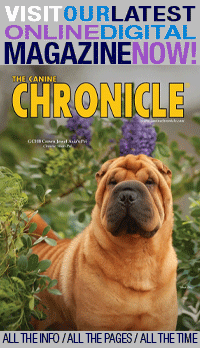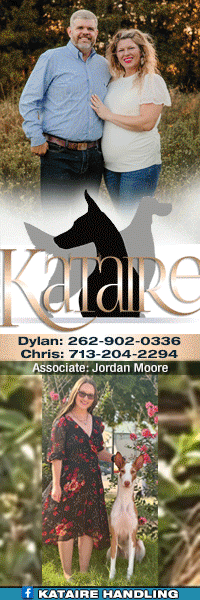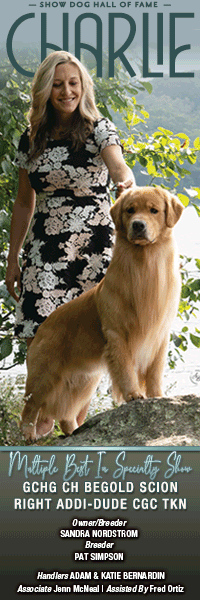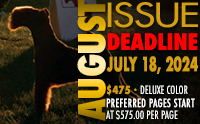Breed Priorities – Rottweilers
Click here to read the complete article
by Nikki Riggsbee
 The Rottweiler is often one of the bigger entries at dog shows and frequently a contender in the working group. It is the second most popular working breed according to AKC registration statistics, after the Boxer, and ranks tenth among all breeds.
The Rottweiler is often one of the bigger entries at dog shows and frequently a contender in the working group. It is the second most popular working breed according to AKC registration statistics, after the Boxer, and ranks tenth among all breeds.
We found twenty-five Rottweiler breeder-judges to invite to take this survey. Nineteen agreed to participate, and sixteen completed surveys were returned. All of the judges had at least twenty years in the breed, the group averaging over thirty-two years. They have judged the breed over eleven years on average. Most have judged their national specialty. Two of the largest regional Rottweiler specialties are the Colonial and the Medallion, and most of the judges have judged one or both of these as well. Some of the group are multi-group judges, others judge only Rottweilers, and others are approved for several to all of the working breeds.
Rottweiler Virtues
The survey included a list of breed characteristics from the Rottweiler standard. The breeder-judges prioritized these virtues, and the ranks were averaged. They are listed on the next page in order from most important to least, based on the average ranks.
1. Robust and powerful dog…compact and substantial build
1. (tie) Temperament confident and courageous…with a self-assured aloofness
3. Back…firm and level
4. Movement…powerful…with strong forereach and…rear drive
5. Proportion… being 9 to 10
6. Ratio of backskull to muzzle…3 to 2
7. Well pronounced forechest
8. Legs…with straight, heavy bone
9. Croup…only slightly sloping
10. Eyes dark brown
11. Elbows…well under body
12. Upper thigh…long, very broad and well muscled
13. Ears medium sized…inner edge lying tightly against the head
14. Size being mid-range of each sex of dogs: 24”-27”; bitches: 22”-25”
15. Feet…round, compact with well arched toes
16. Clearly defined rust markings
The greatest agreement was on the two virtues that tied for first: “Robust and powerful dog…compact and substantial build” and “Temperament confident and courageous…with a self-assured aloofness.” Nearly as many concurred on “Back…firm and level” (3rd). Right behind those were “Movement…powerful…with strong forereach and…rear drive” (4th) and last place “Clearly defined rust markings.” Seventy-five percent or more agreed on the value of these five virtues.
Virtues with eleven surveys agreeing were “Legs…with straight, heavy bone” (8th) and “Ears medium sized…inner edge lying tightly against the head” (13th). More than sixty percent concurred on “Proportion… being 9 to 10” (5th), “Elbows…well under body” (11th), and “Feet…round, compact with well arched toes” (15th). “Well pronounced forechest” (7th), “Eyes dark brown” (10th), and “Size being mid-range of each sex (dogs: 24”-27”; bitches: 22”-25”)” (14th) had the smallest majorities in agreement.
Half of the group was together on “Upper thigh…long, very broad and well muscled” (12th). The remaining virtues had seven surveys’ ranks clustered near enough to be deemed agreement: “Ratio of backskull to muzzle…3 to 2” (6th) and “Croup…only slightly sloping” (9th). The remaining opinions on these three virtues varied widely, from very important to not important at all compared to the other features.
Some average ranks were very close to each other so that additional input could change the relative positions. One more survey would break the tie at first. “Back” (3rd) and “Movement” (4th) were less than a tenth of a point apart as were “Ears” (13th) and “Size” (14th).
Third place “Back” was more than two points below the tied first place “Robust, powerful” and “Temperament,” emphasizing the importance of the first two. More than two-and-a-half points separated “Proportion (overall)” and “Backskull/muzzle ratio,” confirming the value of the first five.
Rottweiler breeder-judges displayed more consistency than in other breed surveys in having majority opinions on the importance of all but three of the virtues. It helps a breed when the experts are pulling in the same direction.
Rottweiler Faults
The breeder-judges also prioritized a set of faults from the standard. Below is the list in sequence by average ranks, from most serious to least serious.
1. Fundamentally shy
2. Angulation of hindquarters not balancing that of forequarters
3. In a trot…the back does not remain level
4. 1 missing tooth
5. Level bite
6. Croup…noticeably more than only slightly sloping
7. Length of body noticeably more than slightly longer than the height of the dog at the withers
8. Ears folded or held away from cheek/head
9. Round eyes (not almond-shaped)
10. Lack of mouth pigment
11. Coarse
12. Wavy coat
13. Oversized
14. Feet not round, compact with well arched toes
15. Insufficient or sooty markings
16. Doggy bitches
“Fundamentally shy” (1st) had the greatest agreement among the faults, with all but three placing it first. This is consistent with “Temperament” tying for first among the virtues. Next, with twelve of the surveys with similar ranks, were “In a trot…the back does not remain level” (3rd) and “Ears folded or held away from cheek/head” (8th).
Nearly seventy percent of the group concurred on “Angulation of hindquarters not balancing that of forequarters” (2nd), “Wavy coat” (12th), and “Doggy bitches” (16th). Several commented that bitchy dogs would be a more serious problem. The next greatest agreement was on “Croup…noticeably more than only slightly sloping” (6th), “Round eyes (not almond-shaped)” (9th), and “Insufficient or sooty markings” (15th). “Feet not round, compact with well arched toes” (14th) was the only other fault that the majority of the surveys valued similarly.
Eight surveys only had agreement on “Length of body noticeably more than slightly longer than the height of the dog at the withers” (7th) and “Oversized” (13th), while others placed them all over.
Half the group saw “1 missing tooth” (4th) as a serious fault, but almost as many placed it mid-point; the same split occurred on “Level bite” (5th). Remember this breed has several disqualifications with mouth faults (overshot, undershot, wry, more than 1 missing tooth).
Some other faults had bi-polar opinions as well. While a majority put “Round eyes” (9th) in the fourth quartile, a good number had it above midpoint. “Lack of mouth pigment” (10th) had seven place it in the second quartile, while an equal number had it in the last quartile. Seven had “Coarse” (11th) towards the bottom, but almost as many had it around the middle, moving its average several placements higher.
Additional input could change placement between “Round eyes” and “Lack of mouth pigment,” which were within a tenth of a point from each other.
“Shy” was two points ahead of “Unbalanced angulation,” emphasizing the importance of temperament. Two-and-a-half points separated “Longer body” and “Faulty ears,” confirming the relative seriousness of the first seven.
While the breeder-judges were not as consistent in ranking faults as they were on virtues, they were still more consistent than many surveys have been, with majority opinions on ten faults. Breed character, temperament, and movement were generally valued in both lists. Head details were closer to the middle, with teeth the more important among these. Size, color, coat, and feet were not high among priorities.
Outlines
The survey included outlines of six Rottweiler dogs and six Rottweiler bitches. The breeder-judges were asked to place each set first through fourth based on the outlines only, and then select Best of Breed.
The outlines were loosely based on real dogs. The experts were advised not to judge based on the feet, though, for they were often hidden in the grass and only approximated in the outlines. The dogs were standing at approximately the same angle, although the head angle varies somewhat.
The judges’ placements were averaged to determine the dogs’ average ranks. Rottweiler “E” had most first place scores and the best average score among the boys. Experts who liked “E” said he had the “proper top and bottom line,” “correct proportions, better head” “compact body,” “smooth outline,” “correct topline/tailset,” and “correct type.” The second place male was Rottweiler “F.” Comments on “F” included “good topline, nice forechest,” “most balanced,” and “proper leg length.”
The Rottweiler bitch “U” had the highest average placement and was also most often placed first among the bitches. The judges who chose her noted “best balance and proportion,” “nice neck and topline,” “moderate angulation, good top and tailset,” and “compact, substantial, but feminine.” Next highest average placement was Rottweiler bitch “Z.” Those who liked her commented about her “correct proportions, better head,” “good topline, nice forechest, balanced,” and good “breed type.”
The Best of Breed Rottweiler with the highest average score, most first placements, and most often designated BOB was dog “E.” Twice as many judges picked “E” than any other Rottweiler. Males win Best of Breed so often in Rottweilers that the breed club has a separate rating scale for bitches, which includes Best of Opposite Sex points. It was good to see that six of the breeder-judges chose bitches as their BOB. Three picked “U,” two picked “Z,”, and one chose “W.”
Essential Characteristics
The breeder-judges were asked what four to six characteristics a Rottweiler must have to be considered a good one. Most often named was temperament, consistent with the virtues and faults lists. Next most frequently mentioned were outline, head, and movement, especially reach and drive.
Comments
The Rottweiler experts offered comments on evaluating their breed.
• Color and markings are important breed characteristics, including dark eyes.
• Judge the dogs moving; very few cover ground the way they should because of poor fronts, toplines, and croups.
• Do not fault judge; look at the whole dog, especially proportion of leg to body.
• Temperament must be correct. The dog must stand for exam, not be shy or aggressive.
• You may have to live with a little unsoundness to get type.
• Movement is important, and they should move with a level topline.
• Sex characteristics should be obvious, dogs must be masculine, bitches feminine.
• Learn correct Rottweiler type, structure, and movement, so lesser dogs don’t win.
• Don’t stare continuously at a Rottweiler’s eyes; it can be taken as a challenge.
• Let the handler show the bite.
• If you are uncomfortable with this breed, don’t judge it. Rottweilers are intelligent and intuitive, and if you are afraid, they will know it.
Thanks to the Rottweiler Breeder-Judges
for sharing their expertise.
Short URL: http://caninechronicle.com/?p=72571
Comments are closed











